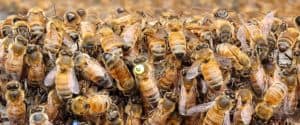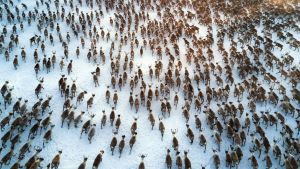All of the organisms in a given location or area are termed an ecosystem. An ecosystem is a location on earth that includes all members, from microorganisms to plants and animals, have enough resources to survive, reproduce and thrive.

Ecosystems are characterized by their diversity. There are many different species present, which means that there are many different ways in which they can interact with each other.
The animals in ecosystems play an essential role in maintaining and forming them. In the context of an ecosystem, the role of an animal as a consumer is one of the crucial elements of community dynamics and energy flow.
All of the living organisms on earth make up the biosphere.
To put it in a more ecological way, the biosphere is comprised of all the ecosystems.
Table of Contents
All of the organisms in a given location or area is termed
All of the organisms in a given location or area is termed an ecosystem. An ecosystem contains the biological community of plants, animals, and microorganisms and the non-living components in a specific location.
Some ecosystems are small and can be found in a backyard garden or a pitcher plant. Like the Amazon Rainforest, other ecosystems are massive and stretch thousands of miles.
An ecosystem can range from tiny to huge areas, from wet to dry, hot to cold, and so on.
Each ecosystem has environmental conditions determining which organisms can live there and what they need to thrive.
A combination of factors generally causes environmental differences between ecosystems. Among these factors are biotic and abiotic factors.
Biotic Factors include the living components such as:
- Plants
- Animals
- Other organisms
Abiotic Factors comprise the non-living environment, which include:
- Extreme weather conditions
- Pollution
- Diseases
- Invasive species
The sum of a species’ use of the biotic and abiotic resources in its environment is called its ecological niche. Ecological niches demonstrate how species adapt to their environmental conditions and how they influence their ecosystem.
Factors that act to limit the growth of populations are collectively called
Factors that act to limit the growth of populations are collectively called limiting factors.
These are usually natural forces, such as disease, predators, or climatic conditions, which prevent the population from growing beyond a certain point.
Limiting factors are environmental constraints on the growth of a given organism or species. In many cases, there is not just one limiting factor but several different ones working together to keep a population within specific boundaries.
Factors such as temperature, humidity, etc make up the part of an organisms environment. So a lack of any of these factors can greatly affect the organisms survival.
For example, a lack of food limits their reproduction rate and prevents them from passing this limitation on to their offspring.
Alternatively, if there is limited space, that limits their ability to find mates and breed with them. Or perhaps an excess of natural predators limits their ability to avoid them in the future by hiding or fleeing.
Many animals form complex societies of related individuals for a variety of reasons. Sociality is adaptive in many species, allowing individuals to gain advantages such as protection from predators.

Sociality also allows for increased access to food and potential mates.
Social interactions also allow animals to learn from others and increase their chances of survival. The ability to form complex social groups is not limited to vertebrates.
Some invertebrates such as some species of ants, bees, and termites, can live in groups.
An animal’s ability to form complex social groups can have important implications for its well-being and survival. For example, some animals living in complex societies can benefit from the knowledge and resources these groups can provide.
However, living in a large group can also pose challenges for some animals. This is becuase each individual must share resources with others.
The movement of organisms into a range is called
The movement of organisms into a range is called Immigration.

Immigration is the movement of an organism from one range into another.
The most common form of immigration is via birds, as many species do not migrate and move between different regions over long distances.
This is in contrast to emigration, which is the movement of an organism out of a given range.
An organism can be both an immigrant and an emigrant at once. Some organisms are capable of mass movements, such as when a disease outbreak or weather changes drive entire populations away from their usual habitat.
Other organisms are more localized, such as when individual animals move into new areas.
The physical location where an organism lives is termed

The physical location where an organism lives is termed a habitat. It is a specific type of environment in which an organism lives and thrives with the help of resources like food, water, and shelter.
The habitat is different from an ecosystem in that habitat is a specific area that the organism chooses to live in.
In contrast, the ecosystem is a collection of living and non-living components. All living organisms in a habitat make up a community. This can include the land, sea, and air surrounding an organism.
Habitat should be suitable for the organism to survive. For example, if it is too hot or cold, the organism may not be able to regulate its temperature properly and will therefore risk getting sick. Furthermore, if the physical environment is toxic or unstable, then it could cause damage to the organism’s organs or make it more prone to disease.
The two main types of habitats are terrestrial and aquatic habitats. These are also known as land and water habitats.
Water habitats include freshwater and saltwater habitats.
Examples of terrestrial habitats include:
- Forests
- Deserts
- Grasslands
- Tundra
- Mountains
Freshwater habitats include:
- Streams
- Rivers
- Swamps
- Marshes
- Ponds
- Lakes
The salinity, or salt concentration, of aquatic habitat, is a critical factor. Organisms adapted to life in saltwater habitats would be unlikely to thrive in freshwater habitats.
Saltwater habitats include:
- Oceans
- Seas
- Salt lakes
- Salt marshes
- Saltwater swamps
Several factors can contribute to destruction of habitats. These factors can either be natural disasters such as storms, tornadoes, hurricanes, erosions, floods, volcanoes etc.
Some of these natural disasters cause harm to trees whereas others affect the soil and vegetation leaving a barren land behind.
This can lead to mass disturbance in wild life living. In some cases, natural disasters can completely destroy the habitat which may be taken over by other species.
Human destruction can cause havoc and serious harm to both terrestrial and aquatic habitats. The most profound cause of destruction by humans is pollution. Other causes also include cutting down trees and building roads and filling wetlands for constructing residential areas.
This can cause habitat loss and divide the already living populations. This can cause a decline in population of species overtime.